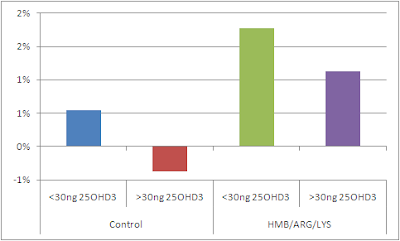Strengthless Gains: HMB+Arginine+Lysine Build Muscle. Strength Gains Require Vitamin D Levels >30mg/mL
 |
| Image 1: I wonder, why gerontologists don't use plain BCAAs - too convenient? |
Did you know that the most recent studies on the effects of vitamin
D on weightloss (Soares. 2011) and type 2 diabetes (Mitri. 2011) conclude that
"[c]urrent evidence from RCTs [randomized controlled studies] did
not consistently support the contention that calcium and
vitamin D accelerated weight or fat loss in obesity" and that,
in the majority of hitherto published, well-powered studies "no
effect of vitamin D supplementation on glycemic outcomes" was
seen "among participants with normal glucose tolerance at baseline
and in three small underpowered (n=32–62) trials of patients with
established type 2 diabetes". The obvious discrepancy between the
euphoria, or I should say, hype the unreliable epidemiological
trials brought about and the disillusioning results of real
science, which will always go beyond mere observation, should remind
you of the ease with which you can design or (mis-)interpret
epidemiological studies in order to prove whatever hypothesis you
want - I do not have to remind you of the "fat lies" related
to the detrimental effects of saturated fats on heart health, do I?
But let's get back to the topic at hand - strengthless muscle
growth. In a year-long double-blinded, controlled
study (Fuller. 2011) John C. Fuller, Jr. and his colleagues from Iowa State
University and the Vanderbilt University Medical Center provided
39 elderly women and 38 elderly men (age 76+/-1.6 years) with an
amino acid supplement which contained either a blend of HMB +
Arginine + Lysine (2.0 g CaHMB, 5.0 g arginine, and 1.5 g lysine)
or an isocaloric non-essential amino acid placebo (alanine
5.6 g, glutamic acid 0.9 g, glycine 3.1 g, serine 2.2 g). The
supplement, of which the heavier participants (>65kg) consumed
1.5x the amount of their lighter age-mates, was to be taken each day, with
breakfast. Based on previous research by Vukovich (2001) and Flakoll
(2004), Fuller et al. hypothesized that the intake of the
HMB-containing amino acid blend would result in statistically
significant gains in both strength and size of the muscles of their
elderly participants.
In fact, HMB has been shown to stimulate protein synthesis
and reverse its inhibition by lowering proteolysis-inducing factor,
lipopolysaccharide, tumor necrosis factor α, and angiotensin II via an upregulation of the mTOR / p70S6k pathway. By
attenuating the activation of caspases-3 and -8, HMB supplementation
may also decrease the formation of reactive oxygen species and the
activation of the ubiquitin-proteosome degradation pathway. If you asked me, however, you would probably see the very same benefits from supplementing with HMB's way cheaper precursor leucine - keep that in mind before you waste your money on a hardly palatable amino acid derivative your body will synthesize on its own, if you just provide the right substrate, i.e. l-leucine from BCAAs, EAAs or just plain whey protein.
In view of the fact that in a previous study by the same group
(Baier. 2009) an identical amino acid supplement had failed to
elicit significant strength increases in a similar subject group,
and based on previous findings by various scientists on the
detrimental effects of full-blown vitamin D deficiency
(<15ng/mL 25OHD3) on muscle strength, Fuller et al. speculated
that there could be a synergy (which does not equal "vitamin D builds strength) or interdependence between the
provision of the leucine metabolite HMB, the vitamin D status of a
person and the ensuing improvements in muscle size and strength.  |
| Figure 1: Relative changes in lean body mass in 77 elderly subjects after one year on a HMB+Arginine+Lysine supplement (calculated based on data from Fuller. 2011) |
The results of their study (cf. figures 1-2) suggest that 'adequate' vitamin D levels (25OH-D3 > 30ng) are not required for the HMG + Arginine + Lysine amino acid mixture to work its muscle building magic on elderly subjects.
 |
| Figure 2: Increase in total leg strength [in ft-lbs] as measured by the sum of knee extension and flexion at 60 and 120 degrees/s in 77 elderly subjects after one year on a HMB+Arginine+Lysine supplement (data adapted from Fuller. 2011) |
Vitamin D and muscular strength in the elderly: Bischoff-Ferrari et al. (2004) found continued
improvements in lower extremity function up to 40ng 25OH-vitD3/mL,
a level well above what has been previously thought necessary for
maximum benefit. Although this does not sound much, clinical trials
such as the one Andres Ernesto Carillo conducted as part of his
dissertation (Carillo. 2010) show that supplementation with 4.000 IU
VitD3, which is way beyond what conservative physicians would deem
tolerable, raised vitamin D in 23 previously deficient individuals
(25OHD levels = 19.3ng/ml; age 26.1 +/- 4.7yrs) levels by no more
than + 2.7ng/mL over control.
A word of caution before you ramp up your supplemental vitamin D intake to a bottle a day: Although this was a "double-blind controlled" trial, the controlled parameter was not vitamin D supplementation, but the HMB+Arginine+Lysine mixture the elderly subjects received - as far as the vitamin D status was concerned, the study was merely observational. That being said, the study may have higher significance than the unreliable epidemiological guesswork, you will hear about in the news almost daily, it does not allow, however, any (not even preliminary) conclusions regarding the potential effect supplemental vitamin D would have had on the outcome of the study. If the low vitamin D level was just corollary to or caused by some other underlying conditions, for example, it would be very unlikely that even 100.000IU of vitamin D would have had a significant effect on the muscular performance of the subjects.


